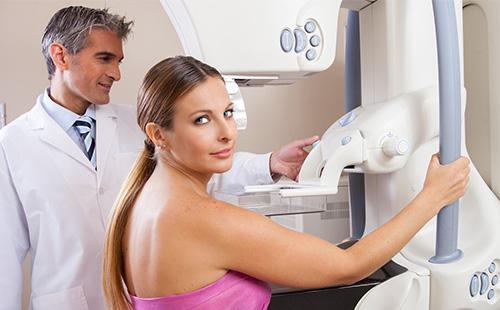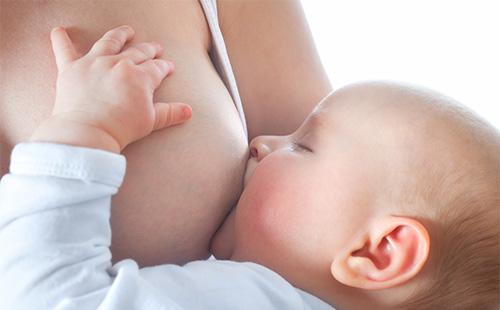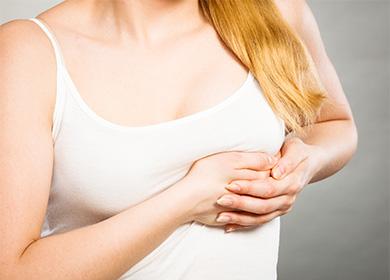The content of the article
Some women confuse the concepts of mastitis and mastopathy, not understanding what the difference is. Mastitis can occur at any time of lactation or even outside of it. This is an inflammation of the breast tissue with a vivid clinical picture. Mastopathy - These are cystic and hyperplastic changes that develop under the influence of hormonal disorders. At the same time, a woman may not be bothered by anything.
The reasons
Mastitis - inflammation of the breast tissue, often occurs during Guards. According to ICD-10, it is encrypted under code N 61. It occurs when two conditions are combined: milk stagnation and the presence of pathogenic microorganisms. Breaking this “chain” can increase the chances of a favorable outcome. Most often, lactational mastitis develops in the following periods:
- on the fourth or seventh day after childbirth - at this time, instead of colostrum, the “arrival” of milk occurs, time is needed to regulate its quantity for the needs of the baby;
- with the introduction of complementary foods - at this point, the baby’s needs in breast milk are reduced, breaks between applications are increasing, which provokes stagnation;
- at the end of lactation - If you sharply try to stop breastfeeding, there is a chance of developing mastitis.
Why lactostasis develops
Lactostasis - stagnation of milk in segments. Each woman encounters him during breastfeeding in varying degrees of severity. Lactostasis occurs due to increased milk production or a decrease in its consumption by the child. The following reasons predispose to this:
- decantation - On-demand feeding is recommended, but some women still adhere to strict time intervals;
- breastfeeding - Each feeding should begin with a “new” breast, so you can evenly empty both mammary glands;
- surface sucking - sometimes babies are “lazy” and suck in milk only until they need to make special efforts, and the “back” milk remains untouched and can stagnate;
- misapplication - It is useful to change postures during feeding in order to empty all lobules equally;
- wrong underwear - during lactation, preference should be given to linen from natural tissues, it should not pinch or squeeze;
- surgical interventions - if ever operations were performed on the mammary glands (for example, it was removed fibroadenoma, already had mastitis), the likelihood of impaired duct obstruction is higher.
"Gates of infection"
Pathogens enter the milk stagnation area as follows:
- through cracks in the nipples - if applied incorrectly or if the child is already with teeth (when biting), wounds arise through which pathogens can penetrate;
- from foci of infection - A sluggish chronic infection (for example, caries, pyelonephritis, sinusitis) or acute (cystitis, colitis, tonsillitis) easily penetrates the mammary glands with a flow of lymph or blood.
Symptoms of mastitis in a nursing mother in stages
Symptoms of mastitis in a nursing mother begin with signs of milk stagnation. Almost every woman has to deal with them, but not everyone is aware of the danger of the situation and the need to resolve the problem. Lactostasis has the following manifestations:
- body temperature is normal;
- the mammary gland is full of milk;
- soreness can be determined locally;
- sometimes tuberosity and compaction are palpated - a filled lobule;
- milk flow is not broken, the baby happily takes his chest.
A woman notes an improvement after feeding or expressing. When the situation worsens, signs of mastitis in the nursing mother appear. What breasts look like with mastitis can be easily found on the Internet, but you should not rely only on photos. The clinical picture is largely dependent on the stage. Information on this is detailed in the table.
Table - How does mastitis manifest in a nursing mother in stages
| Stage | Symptoms |
|---|---|
| Tissue Infiltration - Serous Mastitis | - The body temperature rises; - clearly defined painful compaction; - the skin over it is red and hot when feeling; - axillary lymph nodes may increase; - the child sometimes refuses a sore chest; - a woman can express milk herself, but the procedure is painful |
| Purulent stage | - There is a fever and intoxication symptoms - weakness, lethargy, dizziness; - the mammary gland is red, veins are clearly visible; - the chest may swell, it becomes larger than the other; - the center of milk stagnation is not so clearly visible due to its general stagnation; - purulent discharge may appear from the nipple; - expressing is extremely painful and cannot express itself, the baby refuses to take this breast |
| Abscess formation | - A woman notes a throbbing pain in a particular area; - severe fever; - swelling, redness of tissues; - upon palpation among dense tissues, a softened area is detected if the abscess is close to the skin |
| Phlegmon and gangrene of the chest | - The woman’s condition deteriorates sharply, sometimes she falls into delirium; - the mammary gland is sharply swollen, cyanotic; - sometimes vein thrombosis develops; - not only breast tissue, but also chest muscles, subcutaneous fatty tissue are involved in the inflammatory process; - dark patches of skin appear - necrosis zones |
Phlegmonous and gangrenous mastitis are rare. Amputation of the breast is sometimes necessary for treatment. These conditions pose a threat to a woman's life.
Classification
Depending on the course of the disease, an acute and chronic relapsing form is distinguished. In the latter case, mastitis is associated with incomplete sanitation of the focus of infection.
According to generally accepted beliefs, breast inflammation is only possible with breastfeeding. However, there is non-lactational mastitis in women. It can occur at any age and is more often associated with a chronic infection in the tissues of the gland. Classification depending on the location and area of the lesion:
- subareolar - inflammation immediately under the areola and nipple;
- intramammary - damage deep inside the mammary gland;
- retromammary - formation of a focus in front of the pectoral muscles;
- total defeat - if several areas are captured;
- mastitis of extra lobules - they are located in the armpits and are found in 10-15% of women, the clinical picture is common, but pain, redness and other symptoms are concentrated in the armpits.
What to do
What should I do if my chest becomes inflamed and mastitis occurs? How is he treated? Can I take medicine and what? In the initial stages of mastitis and with lactostasis (in this case there is no temperature), you can try to cope with the situation yourself. But if there is no confidence or sufficient knowledge, it is better to use the services of midwives or a doctor. Komarovsky, by the way, in no case advises weaning the baby from the chest during the period of the disease, this can only complicate the situation.
General recommendations on how to cure mastitis during breastfeeding are as follows:
- decant or feed - to eliminate stagnation, milk evacuation is necessary, if the baby refuses to suckle, you should express yourself or use a breast pump;
- take a warm shower - water will help a woman to mentally relax, and warm water will relieve spasm of the ducts;
- drink antispasmodics - No fear, you can take "No-shpa", "Papaverine", this will help establish the outflow of milk.
Do not do the following:
- causing severe pain by decantation;
- take pills to suppress lactation on your own;
- warm up with obvious signs of inflammation;
- feed the baby with purulent discharge.

Drug treatment
With a persistent increase in temperature above 37.5-38 ° C during the day, it is necessary to start taking serious medicines. Only a doctor prescribes them, self-administration can harm the baby. The following drugs are used in treatment regimens.
- Antibiotics. While taking some, it is allowed to continue breastfeeding ("Cefazolin", "Cefotaxime", "Amoklav", "Azithromycin”), While others will have to temporarily express (Metronidazole, Clarithromycin). The scheme and dose of antibiotics for mastitis for a nursing mother are determined by the doctor.
- Antipyretic. All drugs in this group penetrate into milk. "Ibuprofen" is considered the most effective and safe in relation to the child.
- Antispasmodics. "Drotaverin", "Papaverine" will help reduce tissue swelling, relieve pain and improve the outflow of milk along the lobules and ducts.
- Oxytocin. Natural discharge occurs with irritation of the nipples. With mastitis in a hospital environment, the drug can be administered intramuscularly or intravenously, stimulating the reduction of ducts and promoting the emptying of the lobules.
- Lactation suppression. In extreme cases, as well as after surgical treatment, drugs may be prescribed to reduce milk production. This is Parlodel, Dostinex.
Folk ways
Folk remedies are effectively used together with the main treatment. Of the most popular, the following can be distinguished.
- Cabbage leaf. It is better to slightly process the sheet with boiling water, then cool and attach to the problem area overnight.
- Baking soda. A small amount should be mixed with water until a mushy state. Put on cheesecloth and make a compress for the night.
- Alder or mint. Grind the dried leaves and soak with water. Apply in the form of a compress on the chest for several hours.
- Coltsfoot. Sprinkle fresh leaves with boiling water and put on the place of compaction, preferably at night.
Operations
If there is no positive dynamics against the background of conservative treatment or there are signs of abscessing of the lobe of the breast, surgery is necessary. Ultrasound of the mammary glands is necessarily performed on the eve of the intervention to select the most suitable method.
Typically, radial incisions are performed to open the abscess, not reaching the areolar region. They install drainages for the active removal of purulent contents. Perhaps dissection of tissues in the fold under the mammary gland (when the abscess is located retro-mammally) or around the nipple with a superficial location.
Complications
Ignoring milk stagnation or untimely treatment can result not only in opening and draining abscesses, but even breast removal. Therefore, if you have complaints, it is better to seek medical help. The consequences of surgical treatment in the future for a woman are as follows:
- a scar is formed on the skin;
- increased risk of cancer in the future due to tissue trauma;
- fistulas may form.
Women after any operations on the mammary glands should undergo a regular medical examination - an ultrasound of the mammary glands and a mammogram after 45 years.

How to prevent an ailment
Prevention of mastitis during breastfeeding includes compliance with the following recommendations.
- Proper attachment. In the postpartum period, you need to learn how to attach the baby to the chest. Moreover, it should capture not only the nipple, but also most of the areola. It is useful to change the position when feeding - sitting, standing, lying, right or left.
- Nipple Crack Treatment. If cracks nevertheless have formed, it is necessary to monitor the hygiene of the breast, additionally lubricate with Bepanten after feeding.
- Comfortable underwear. You should choose a special bustier for nursing, which provides convenient fasteners.
- Self-massage. Before feeding, it is useful to carry out light massaging movements from the base of the mammary gland to the nipple.
- On-demand feeding. It is recommended to put the child to the chest every time with anxiety and crying, before and after sleep. It can be every half hour, and sometimes there will be a break of three to four hours.
- Hygiene. The mammary glands should be washed once or twice a day.
- Injury prevention. The chest should be protected from compression, shock, including damage the baby can inadvertently inflict. During sleep, it is necessary to choose a comfortable position on the side or back, so as not to injure the mammary glands.
The causes of lactational mastitis are hidden in the stagnation of milk and the active reproduction of pathogenic microorganisms in this focus. Diagnosing the disease at home is possible according to the characteristic clinical picture of mastitis. In the absence of the effect of an independent treatment, you should immediately consult a doctor to avoid serious consequences and, if possible, surgery. Reviews of women confirm that even after mastitis, lactation can be maintained.
Reviews: “Don't mess with this!”
Hello! I haven’t been feeding it for 8 months already, 1.8 years old. She fed on demand for half a year, there were no problems with breasts. When I began to give lures, literally drop by drop, stagnation began. It sucks like normal, chest overflow was not felt, after a couple of hours the temperature was 37.5. At first I couldn’t understand anything, I was actively expressed, it passed the next day. So it was 3 times, the last one rose to 38, ran to the consultation, appointed a physio, passed. So nothing better helps physio)
Rats https://deti.mail.ru/id1002848092/
Oh girls, I don’t know what form of mastitis I had, but it was terrible! There was a lot of milk, but I did not decant because my son sucked everything up to the drop (on demand). When my son turned 1 month old, my chest started to hurt sharply. It was not even possible to raise a hand from that side, the pain was hellish. The temperature rose sharply 39.3, chills, fever, chest of stone, not to touch, green milk was seeping. Well, my mom is a walking encyclopedia, I’ve slept to treat me. I drank paracetamol (we were advised in an ambulance), and made compresses from starch and sunflower oil and decanted every two hours. My torment lasted 4 days and everything passed. The main thing to believe! Now my son is 6 months old. He weighs 10,300.
Olga Semchenko, https://deti.mail.ru/id1007077110/
I did not drink antibiotics, at my own peril and risk. Thank God everything worked out. I applied gauze moistened with furatsillinovoy alcohol on my chest (I was generally advised with vodka, but it was not found in the house then), on top was a cabbage leaf. And expressed continuously for a day or two.But I want to tell you - the effectiveness of the child in terms of eliminating milk from the breast far exceeds pumping. Sasha saved me. She put it on her sore chest more often than usual. When the temperature returned to normal, she did at the antenatal clinic - I don’t know what it is called - in general, ultrasound tightens the breast and milk expresses easier. But at high temperatures, this seems to be impossible. Only there is one “but”. I’m a completely distant person from medicine and I could very much be mistaken, but if purulent mastitis has developed, then antibiotics are needed, and I have big doubts about the possibility of feeding a child.
Zhenya Shushkova, http://www.komarovskiy.net/forum/memberlist.php?mode=viewprofile&u=214&sid=0a7f9d36dbb9c35dbefdacb391267f37
In my first week of feeding, one breast also hardened, redness started, the temperature rose. In addition to pumping, ice helped me VERY well. In the freezer, ice was frozen in the form of cubes (then it was put in a bag) or just bottled water. After each feeding, it was decanted, then it was simply massaged, rubbed the tubercles, and for 15 minutes kept ice on the sore chest (not directly to the body, through the shirt or marlechka). When my obstetrician advised me, I honestly wondered how it was ice on my chest. Everywhere, after all, they write that breasts should not be chilled. It's okay, even when you hold it, it becomes easier. After the ice, I applied cabbage or a compress of cottage cheese (in marlechka, and on top a plastic bag, so that the clothes would not get wet) - but this is not very convenient, because constantly subsiding, one must lie. I didn’t drink any pills.
Svetik_and_Dimuljka, http://www.komarovskiy.net/forum/memberlist.php?mode=viewprofile&u=15&sid=0a7f9d36dbb9c35dbefdacb391267f37
I had mastitis when the third was a month. I flew to the balcony in early December to remove my underwear. Took off, called. The next day, they took me to the ambulance with a temperature of 40. The doctor said that another day - operations could not be avoided! Do not mess with this. They injected antibiotics, did UHF, and much more. Fortunately, my daughter was lying with me. I fed her almost every hour and all the time I started with a sore chest. Compresses are only good for stagnant milk and when ducts become clogged. Then cabbage and honey. Stop feeding only in case of purulent discharge. Apply to the chest as often as possible, and in different positions. If the husband is nearby, let him help.
Tit, https://mnogodetok.ru/memberlist.php?mode=viewprofile&u=2050&sid=0facaae7d4f9ea84e6103784a9dca8a9

